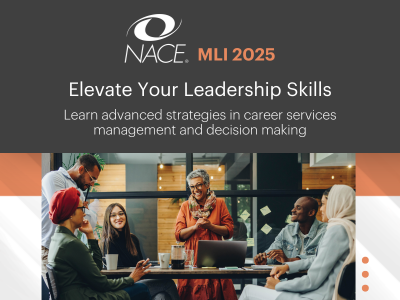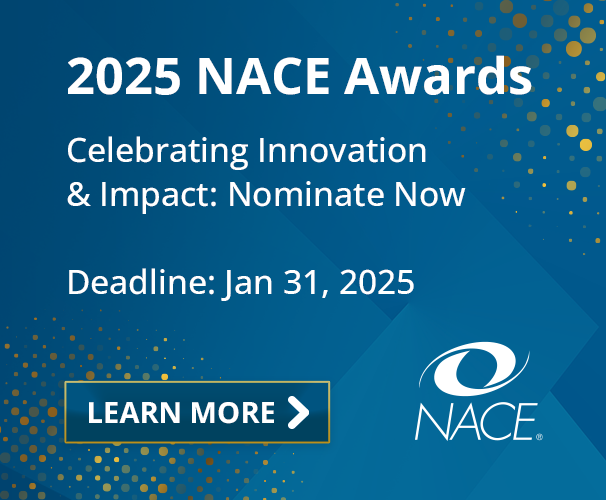NACE Journal, November 2015
While we were thinking about the future, it snuck up on us and is, in many ways, already here.
Like every profession, the field of career services has always been concerned with its future. Over the years, and in regular waves of attention, countless workshops, white papers, and discussions have explored and projected the changes to come in career services and the implication of those changes for practitioners and organizations. It should come then as no surprise that we are currently riding another wave of prognostication.
The current drive to better understand and anticipate our future may be distinctive in that it is influenced by certain environmental factors that threaten a potential sea change in higher education. The rising cost of higher education is unsustainable, and never before has the value of a college degree and the career outcomes it historically promises been so highly questioned and doubted. Interest in lower-cost and more efficient alternatives to traditional higher education models has never been greater. The implications of political turmoil and a truly interdependent global economy continue to bring new challenges and instability to traditional economic and labor force principles and projections. The one clear implication in response to these forces is that career services is being called upon to play a central role in helping produce the successful career outcomes higher education promises and society now increasingly demands.
Chan's (2013) proclamation that "career services must die" became a rallying cry for many long-suffering practitioners who felt career services never received the appropriate levels of support and expressions of value that were merited. Chan argued that new models and new ways of thinking were critical in confronting the new challenges to higher education, and essential to positioning career services more centrally and prominently within the higher education community. Interestingly, the proclamation also prompted a spirited response by those practitioners representing programs and institutions that were already well underway in developing the new model of career services Chan described. This seeming inconsistency is really not surprising since the "future" never arrives all at the same time and fully formed. Instead, the future often sneaks up on us, making itself known in ways small and large, and, if we are fortunate, at a pace to which we can readily adapt and adjust.
Dey and Real (2010), and subsequently Cruzvergara and Dey (2014) and Dey and Cruzvergara (2014), described the evolution of career services in a series of changing operational paradigms that included vocational guidance, teacher guidance, job placement, career counseling, and professional networking, and that pointed to an emerging model characterized by innovative connections and partnerships, and the emergence of career communities. Devlin and Helbig (2013) described six strategic themes that would characterize the future of career services work, touching on issues of leadership, communications, metrics, self-service delivery, new resources, and a new organizational paradigm. Contomanolis and Steinfeld (2013; 2014a; 2014b) focused particularly on issues of future organizational leadership and practitioner skill sets necessary to support the new emerging paradigm of career services. The National Association of Colleges and Employers (NACE) has contributed to the discussion by providing an ongoing forum to give greater voice to the diversity of perspectives concerning the future of career services and recruiting.
We posit that while we are thinking and writing about the future of career services, it has indeed snuck up on us and, in so many ways, is now already here. Consequently, while there are many analytical dimensions from which to describe our new reality, we have chosen to focus here on four themes driving the emerging paradigm of career services work and which we believe are most often front of mind for practitioners and career services organizations.
These include the themes of staff, collaboration, analytics, and technology.
Staff: Mindset, Skills, Flexibility
While it is clear to us that there is no one specific organizational model that is best suited to undertaking the challenge of career services work today and tomorrow, it is also abundantly clear to us that the staff who are the lifeblood of our organizations are changing to respond to our new operating environment.
We believe staffing, especially in a time of change, is not about years of experience, but it is about the right mindset and perspective, the right skills and interests, and the ability to be flexible and adapt. As the current era of career services continues to focus on connections and communities, it has become essential for staff to be strong facilitators of groups and synthesizers of information. They must be approachable, engaging, and responsive. They must be strategic, politically savvy, relationship-building change agents. And if that isn't enough, they must be both specialists and generalists, with the ability to customize their efforts to the needs of diverse stakeholders and to wear multiple hats in fast-paced, demanding roles.
In short, we believe that career services staffs must transform their roles into educators who complement the work of their faculty partners rather than transactional service providers.
Some are too quick to suggest that such "super staff" don't exist, but we assert that they do, and function in many career services organizations in all types of institutions across the country. We know them; we've seen them work. The challenge for us as a profession is to identify the right talent, attract that talent to our work, hire and develop them, and support their efforts on behalf of our organizations. Talent development is particularly important as we understand the needs and interests of our Gen Y colleagues. All this, of course, takes leadership and the right kind of leadership for these changing times.
For leaders of career services today, the primary role is no longer just running the operation. It is also about being externally focused, visionary leaders who can engage and connect with stakeholders, provide thought leadership concerning the efforts of their organizations, and connect the activities and outcomes of our work to institutional priorities, goals, and mission. Leadership in career services today requires individuals who are highly effective communicators who can build momentum and foster buy-in for needed strategic initiatives.
Of equal importance is the ability to attract and develop talent. Effective career services leaders today hire for attitude and train for skills. They invest heavily in people by placing them in roles and assigning them responsibilities that align with their strengths, and they dedicate time and resources to staff training and professional development. In other words, they invest in their people.
Effective leaders today realize their leadership approach must be situational to accommodate the diversity of talent, interests, and capabilities among every team. Leaders need to gain trust, communicate effectively, and motivate performance. Building an effective team demands that leaders articulate a clear vision, establish clear expectations, and both challenge and support their team members in accomplishing individual and organizational goals and objectives.
People have always been the most valuable resource any career services organization possesses. With the changing operational landscape and each new generation of professionals comes the need to recalibrate our thinking to focus on the types of people and skills that are needed, and the type of work that now must be done. A commitment to this "staff recalibration," in turn, also makes evident the institution's responsibility to "recalibrate" its support of career services. Today, this means that institutions must provide career services with resources at levels necessary to achieve the outcomes expected of them. It also means institutions must empower career services leaders by positioning their offices appropriately within the institutional organizational structure, and providing the needed visibility and expressed importance of our work and contributions.
Collaboration: Multiple Levels, Multiple Partners
At the heart of the era of "connected communities" (Dey & Cruzvergara, 2014b) is the critical notion of collaboration. No career services organization is successful without the benefit of key partnerships and collaborations. In fostering the connected career communities that characterize our work, we need to approach these partnerships with new energy and commitment. Elevating career services work demands that key stakeholders benefit from any collaborative efforts and that there is great confidence in the ability of the career services organization to deliver outstanding service and deliverables. The key is to find ways to collaborate on multiple levels with multiple partners to jointly accomplish the shared goals and objectives of most value to the institution.
Despite many examples of innovative partnerships and collaborations, our collective past was too often characterized by "turf wars," concerns about loss of control, and fears that partnerships might dilute whatever credit and reward was potentially in the offing.
Collaboration opportunities abound if we are open to explore and negotiate them with everyone's interests in mind. Every career services organization should, for example, have working partnership arrangements in place with alumni relations; fundraising and development; admissions; academic advisers; selected faculty, researchers, department heads, and academic administrators; appropriate student services organizations; student employment and community service organizations; student clubs and organizations; institutional research; and institutional assessment and planning.
New realities are creating new synergies and partnerships with, for example, compliance and risk management organizations to address issues with internship and other experiential learning opportunities. There are new and innovative collaboration opportunities as well with disability services in the quest to better identify and support the career needs and interests of the growing number of college students with disabilities.
Much of what is possible is idiosyncratic to the institution and the career services organization, but, clearly, the exploding need for data and information, the necessity of leveraging limited resources, the growing needs and expectations of special populations, the "responsibility sharing" explicit with satellite career services units and increasingly apparent in academic advising, and the pressures to document and report career outcomes are all among the forces at work that potentially bring partners to the table.
The key to collaboration today is building relationships—reaching out to key individuals and organizations, understanding their needs and interests, and finding common ground. Based on that foundation of trust and knowledge, joint initiatives are more likely to reflect the interests of both parties and enhance the chances for success. Collaboration can be more challenging when there are differing opinions by well-intentioned people as to how best to achieve a common goal. In those instances, always emphasize the interests and needs of the clients and stakeholders you are trying to serve. If you can always keep client satisfaction first, it is easier to work back to a common ground. Just remember: Collaboration does not mean that everything will always work the way you want. There is always some measure of compromise. This is much easier to accept when you put the needs of clients and stakeholders first.
Analytics: Better Data, Better Analyses
We have clearly entered the era of informed decision-making and, as we like to say, "Data is the new bacon." In the past, the intuitive sense of what should be done based on our experience was always the decisive factor in choosing one strategy or action over another. While this continues to be necessary, it is no longer sufficient. In this increasingly data-driven age, we must rely on data and metrics to assess and evaluate all our activities and actions. Senior leaders and colleagues want to understand precisely what data—qualitative or quantitative—and what analyses informed our decision-making.
Institutional and academic program accreditation efforts, which have increasingly focused on measurable learning outcomes and effective use of assessment, along with client and stakeholder demands for better career outcomes information, have certainly been driving forces in the emphasis on data and analytics. While for many, the NACE standards on graduating student first-destination outcomes signaled that the age of accountability and metrics had finally arrived to career services, doing so would ignore the many efforts to better understand and assess our work already well underway. Surveys, focus groups, and other forms of evaluation and assessment, for example, have been techniques embraced by career services professionals for some time.
What is distinctive about our work today, however, is the growing sophistication in our data collection and analysis. We are not just collecting first-destination career outcome data, for example, but we are analyzing it more critically, identifying trends, and adjusting our efforts accordingly. Combining the data housed in our enterprise systems with outcomes data, for example, allows us to build predictive models that help explain the positive relationship between certain career outcomes and candidate activities.
We are becoming more sophisticated in assessment, for example, by combining survey data with usability studies to allow for better website services design, or in using student focus groups to help in the final design and layout of marketing and branding materials or selecting among potential workshop topics. We are using reputation measures to better understand what our stakeholders are potentially saying about us and focusing our evaluation efforts on more specific audiences to better understand—and respond to—what subsets of clients really desire and need from us to be successful.
Many offices today have identified key performance indicators, which they track using dashboard metrics. Analyzing these metrics and identifying trending developments allow us to more strategically reposition resources or shift priorities to ensure desired results and outcomes.
Career services organizations are also increasingly being swept up into the "big data analytics" that have been driving the corporate world for some time and increasingly penetrating the higher education world as well. New and existing enterprise system providers are looking at ways to leverage student data across multiple institutions and multiple student populations to better understand emerging trends and provide more in-depth and meaning analysis to recruiting organizations, career services organizations, and student users. These efforts will potentially also inform other stakeholders, including those in the government and public policy space, potentially strengthening higher education's value proposition.
In many ways, we are more quantitatively focused than ever before, but it's important to recognize that the data in and of itself are not what's of the most value and importance. The analysis of that data and the story we are able to tell about our efforts based on that data is a vital part of the emerging new paradigm of career services. Better data and better analyses allow us to more fully understand and articulate what we are doing well, and identify the best opportunities for performance improvement.
Technology: Innovative, Enhanced, Integrated
Social media and related technologies have fundamentally transformed the way people interact and connect, and how we all experience services and products. Today's students have very sophisticated expectations for the way technology facilitates their campus experience and their interactions with the world outside of their institutions. In similar ways, employing organizations increasingly rely on social media and technology to enhance their recruiting efforts and engage more meaningfully with candidates. As a consequence, career services organizations must be attentive to the latest technology innovations and applications that relate to our work. Indeed, today they may be in a better position to influence the direction and nature of those technology applications than ever before.
Technology innovations and enhancements are, by nature, disruptive, and career services organizations must be able to recognize the implications of these changes and contribute to them in ways that potentially advance our capabilities. Today's generation of students expect simple, intuitive, interactive, and customizable technology interfaces. Employers are increasingly focused on tools that help identify and engage candidates more quickly and efficiently.
There have been a number of technology responses to these circumstances. New career services enterprise systems have been introduced that have more user-friendly interfaces, new predictive algorithms, more sophisticated machine learning, and better social media integration. There are many more mobile applications and mobile friendly websites. There are many more online applications that assess candidates and then seek to connect them to specific positions, employers, or industries based on that assessment. There are more specialized tools for specific functions and activities (e.g. career fairs, student event marketing, student feedback about employers and jobs). Increasingly, application and system developers are involving students and career services professionals in the design and development of technology tools.
Technology developments are also essential to our emphasis on analytics and accountability. Technology tools allow us to more effectively collect, analyze, and present data. Infographics allow us to tell our organizational stories in more visually compelling ways, and the variety of e-publications and targeted messaging tools allow us to share content and essential branding messages more strategically and broadly.
As a profession, we are on the cusp of a whole new generation of innovative and enhanced technology products and services that provide the functionality we and our clients and stakeholders demand and expect. These new technologies allow career services to deliver more desirable outcomes and demonstrate greater value to our institutions.
It's Here!
The "future" of career services that many of us have been predicting is already here. The challenge—and opportunity—for all of us is to embrace this new world with energy and enthusiasm; to recognize the potential that these new priorities, expectations, and tools provide us to elevate career services work and position us for success now and into the future.
Sources
Chan, A. and Derry, T. (Eds.). (2013). A roadmap for transforming the college-to-career experience: Rethinking success from the liberal arts to careers in the 21st century. Winston-Salem, NC: Author.
Contomanolis, E. & Steinfeld, T. (2013). "Career services leadership: Some guiding principles." In E. Contomanolis & T. Steinfeld (Eds.), Leadership in career services: Voices from the field (pp. 10-19). Amazon CreateSpace.
Contomanolis, M. & Steinfeld, T. (2014a). "Thriving in the brave new world of career services: 10 essential strategies." LinkedIn Pulse. Retrieved from https://www.linkedin.com/pulse/20140506212412-2872947-thriving-in-the-brave-new-world-of-career-services-10-essential-strategies?trk=prof-post.
Contomanolis, M. & Steinfeld, T. (2014b). "The new breed of career services professional: What's in the secret sauce of success?" LinkedIn Pulse. Retrieved from https://www.linkedin.com/pulse/20141016190028-2872947-the-new-breed-of-career-services-professional-what-s-in-the-secret-sauce-of-success?trk=prof-post.
Cruzvergara, C. & Dey, F. (2014). "10 future trends in career services". LinkedIn Pulse. Retrieved from https://www.linkedin.com/pulse/20140715120812-11822737-10-future-trends-in-college-career-services.
Devlin, T. & Helbig S. (2014). "The future of career services." In E. Contomanolis & T. Steinfeld (Eds.), Leadership in career services: Voices from the field (pp. 223-235). Amazon CreateSpace.
Dey, F. & Real, M. (2010). "Emerging trends in university career services: Adaptation of Casella's career centers paradigm." NACE Journal, 71, 31-35.
Dey, F. & Cruzvergara, C. (2014). "The evolution of career services." In K. K. Smith (Ed.). Strategic directions for career services within the university setting. (pp. 5-18). New Directions for Student Services, Number 148; San Francisco: Jossey Bass
Editor's Note: This article is based on the "New Paradigms, New Expectations, and New Opportunities in Career Services" session presented by the authors at the NACE 2015 Conference & Expo, June 3, 2015, in Anaheim, California.




